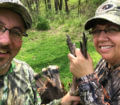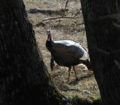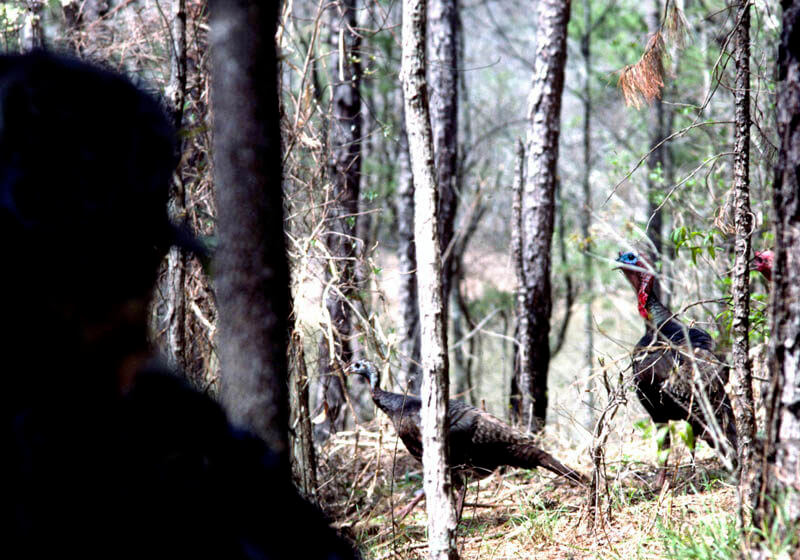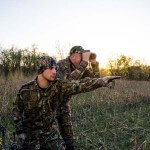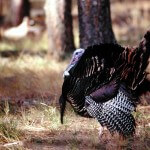Editor’s Note: An outdoor writer friend of mine came in from turkey hunting with his head down, looking dejected. Instantly I knew what had happened. “You missed him, didn’t you?” I asked my friend, whose name must remain anonymous to protect the guilty. “Yeah, I missed him,” he replied. “You’re not going to believe this, but that’s the first gobbler I ever missed.” From his response, I knew that my friend hadn’t hunted turkeys very much. I looked at him and smiled. “If you can make that statement in all honesty, then I know that you haven’t taken more than six turkeys in your lifetime.” My friend smiled a sheepish grin and said, “Yeah, I’ve bagged about six birds.” The one thing I know for certain is that the only people who don’t miss turkeys are the people who don’t hunt them. Regardless of how well you shoot, how close you let the turkeys get, what type of gun and ammunition you use, and how many years you’ve hunted, you’re still going to miss turkeys. Turkeys have an uncanny ability to dodge shots. I don’t know how they do it; they just do. This week we’ll look at reasons why I’ve missed turkeys. Most hunters probably won’t tell on themselves. However, I know that the turkey hunters who read this article will appreciate my honesty and perhaps learn from my mistakes.
 Scott Dillon, once a guide at White Oak Plantation in Tuskegee, Alabama, and I had hunted the same flock of turkeys for two days. We knew that four big gobblers were living on the property line. Sometimes these birds were on White Oak’s property; then at times they were on the neighbor’s property. One morning the neighbor was hunting the same four gobblers we were. The birds had been talking for about two hours, and we’d set-up and attempted to call them about five times. The neighbor also was calling to the turkeys. As he moved closer to the property line, so did the gobblers. “I think the neighbor’s going to drive those gobblers right to us,” Dillon commented. “Let’s move up to one of these little valleys and wait for them.”
Scott Dillon, once a guide at White Oak Plantation in Tuskegee, Alabama, and I had hunted the same flock of turkeys for two days. We knew that four big gobblers were living on the property line. Sometimes these birds were on White Oak’s property; then at times they were on the neighbor’s property. One morning the neighbor was hunting the same four gobblers we were. The birds had been talking for about two hours, and we’d set-up and attempted to call them about five times. The neighbor also was calling to the turkeys. As he moved closer to the property line, so did the gobblers. “I think the neighbor’s going to drive those gobblers right to us,” Dillon commented. “Let’s move up to one of these little valleys and wait for them.”
I sat down by a tree facing the valley and got ready. Dillon sat behind me where he could see both sides of the valley. He made three light clucks and then whispered, “Look to your left, John. All four longbeards are coming up the valley.” Since I’m a left-handed shooter, I had a very-limited field of view to my left. “I can’t see the turkeys,” I told Dillon. He responded, “They’re coming straight at us, John. Look hard left.” “I still can’t see them,” I told Dillon. “I’ve got to turn all the way around if I’m going to get a shot.” A full minute passed, and Dillon finally said, “Okay, turn around on the tree, and you’ll see the gobblers.”
 I turned to my left and saw a red head at about 30 yards. Bringing my Remington 870 (www.remingon.com) to my shoulder, I looked through my scope and positioned the turkey’s head in the center of the reticles. However, just as I squeezed the trigger, I noticed a baseball-bat-sized tree covering the turkey’s head. “You missed him,” Dillon said as he began to cluck loudly on his slate call. “Look hard right. I saw a second gobbler’s head.” This time when I centered the turkey’s head in the diamond shape of my scope and squeezed the trigger, that bird went down.
I turned to my left and saw a red head at about 30 yards. Bringing my Remington 870 (www.remingon.com) to my shoulder, I looked through my scope and positioned the turkey’s head in the center of the reticles. However, just as I squeezed the trigger, I noticed a baseball-bat-sized tree covering the turkey’s head. “You missed him,” Dillon said as he began to cluck loudly on his slate call. “Look hard right. I saw a second gobbler’s head.” This time when I centered the turkey’s head in the diamond shape of my scope and squeezed the trigger, that bird went down.
After Dillon and I collected the downed gobbler, we went to look for the first gobbler. “The bad news is you missed him,” Dillon explained. “The good news is you missed him cleanly. You only cut one feather, and there’s no sign that the bird was injured.” “Well, I actually saw the first gobbler run off,” I tried to explain. “That’s the reason I swung on the second bird. I knew I didn’t touch the first bird.” The truth was that I was so intent on taking a gobbler, my eyes played tricks on me. I didn’t notice the tree limb between me and the bird until after I pulled the trigger.
The Black-Powder Gobbler:
 Another time, I had my black-powder shotgun when I hunted with Bo Pitman, longtime turkey hunter and guide, from Tuskegee, Alabama. I rested my gun on my knee and hammer back, ready to make a shot. The first turkey to pass through a small opening in the foliage was a jake. The second turkey to step into the opening was a longbeard. But I opted not to take him because the last bird in the parade was a big, strutting gobbler. Pitman said, “You’d better take the shot. That bird is getting nervous.” Aiming carefully and accurately at the only tom I could see, I squeezed the trigger. A cloud of black smoke obstructed my view, but I stood up quickly after the shot and saw my turkey flopping. Laying my gun down, I began to race toward the bird. I thought to myself, “Boy, that black-powder shotgun sure must have blown that turkey back a long way because he’s much farther out than he was when I shot him.” When I reached the downed gobbler, I noticed that he had only a 3-½-inch beard. “I can’t believe I shot that turkey’s beard off,” I murmured to myself. “Wait. This gobbler looks like a jake, not the longbeard I tried to shoot.” I couldn’t believe my eyes. When Pitman saw the gobbler he said, “John, if I hadn’t seen it, I never would have believed it. Did you see what happened?” “Yeah,” I said. “The longbeard stepped into the hole, and I shot him.” Pitman began to laugh. “That’s not exactly how it happened. Just as you squeezed the trigger, the longbeard dropped down and ran. This goofy jake was standing behind the hill about 50 yards from where we were sitting. Apparently a stray pellet found its way to his neck and head area. You missed the bird you were aiming for, but you still took a turkey today.”
Another time, I had my black-powder shotgun when I hunted with Bo Pitman, longtime turkey hunter and guide, from Tuskegee, Alabama. I rested my gun on my knee and hammer back, ready to make a shot. The first turkey to pass through a small opening in the foliage was a jake. The second turkey to step into the opening was a longbeard. But I opted not to take him because the last bird in the parade was a big, strutting gobbler. Pitman said, “You’d better take the shot. That bird is getting nervous.” Aiming carefully and accurately at the only tom I could see, I squeezed the trigger. A cloud of black smoke obstructed my view, but I stood up quickly after the shot and saw my turkey flopping. Laying my gun down, I began to race toward the bird. I thought to myself, “Boy, that black-powder shotgun sure must have blown that turkey back a long way because he’s much farther out than he was when I shot him.” When I reached the downed gobbler, I noticed that he had only a 3-½-inch beard. “I can’t believe I shot that turkey’s beard off,” I murmured to myself. “Wait. This gobbler looks like a jake, not the longbeard I tried to shoot.” I couldn’t believe my eyes. When Pitman saw the gobbler he said, “John, if I hadn’t seen it, I never would have believed it. Did you see what happened?” “Yeah,” I said. “The longbeard stepped into the hole, and I shot him.” Pitman began to laugh. “That’s not exactly how it happened. Just as you squeezed the trigger, the longbeard dropped down and ran. This goofy jake was standing behind the hill about 50 yards from where we were sitting. Apparently a stray pellet found its way to his neck and head area. You missed the bird you were aiming for, but you still took a turkey today.”
To learn more about turkey hunting, check out John E. Phillips’ print, Audible and Kindle turkey books at https://johninthewild.com/books/#turkey. For a free copy of John E. Phillips’ “The Turkey Gobbler Getter Manual,” go to https://johninthewild.com/free-books/.
Tomorrow: How Canting Your Shot Can Make You Miss a Turkey

